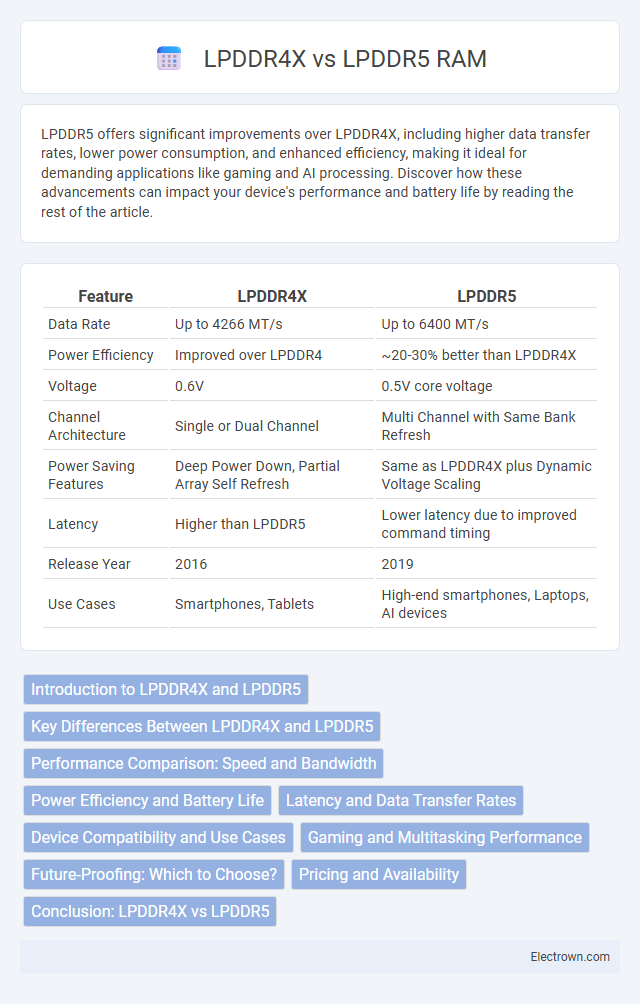LPDDR5 offers significant improvements over LPDDR4X, including higher data transfer rates, lower power consumption, and enhanced efficiency, making it ideal for demanding applications like gaming and AI processing. Discover how these advancements can impact your device's performance and battery life by reading the rest of the article.
Table of Comparison
| Feature | LPDDR4X | LPDDR5 |
|---|---|---|
| Data Rate | Up to 4266 MT/s | Up to 6400 MT/s |
| Power Efficiency | Improved over LPDDR4 | ~20-30% better than LPDDR4X |
| Voltage | 0.6V | 0.5V core voltage |
| Channel Architecture | Single or Dual Channel | Multi Channel with Same Bank Refresh |
| Power Saving Features | Deep Power Down, Partial Array Self Refresh | Same as LPDDR4X plus Dynamic Voltage Scaling |
| Latency | Higher than LPDDR5 | Lower latency due to improved command timing |
| Release Year | 2016 | 2019 |
| Use Cases | Smartphones, Tablets | High-end smartphones, Laptops, AI devices |
Introduction to LPDDR4X and LPDDR5
LPDDR4X is a low-power DRAM standard designed to improve energy efficiency and performance in mobile devices, offering data rates up to 4266 Mbps and reduced power consumption compared to its predecessor LPDDR4. LPDDR5 enhances these features further by delivering transfer speeds up to 6400 Mbps and incorporating improved power management techniques, such as Data-Copy and Write-X commands, to optimize battery life. Both standards focus on balancing high bandwidth with low power usage, making them essential for modern smartphones, tablets, and ultrabooks.
Key Differences Between LPDDR4X and LPDDR5
LPDDR5 offers significant improvements over LPDDR4X in terms of data transfer speed, with LPDDR5 reaching up to 6400 Mbps compared to LPDDR4X's maximum of 4266 Mbps. LPDDR5 introduces enhanced power efficiency through features like dynamic voltage scaling and deeper low-power states, reducing energy consumption in mobile devices. The architecture of LPDDR5 also includes improved reliability and error correction mechanisms, supporting higher performance in demanding applications such as gaming and AI processing.
Performance Comparison: Speed and Bandwidth
LPDDR5 offers significant improvements over LPDDR4X in both speed and bandwidth, with data rates reaching up to 6400 Mbps compared to LPDDR4X's maximum of 4266 Mbps. This increase translates to enhanced system responsiveness and faster multitasking capabilities, benefiting applications that demand high memory throughput. Your device running LPDDR5 RAM will experience smoother performance, especially in intensive tasks like gaming and 4K video streaming.
Power Efficiency and Battery Life
LPDDR5 RAM delivers up to 20% better power efficiency compared to LPDDR4X, thanks to advanced low-voltage operation and improved data signaling techniques. This enhanced efficiency directly translates to longer battery life for your mobile devices, reducing energy consumption during high-performance tasks. Choosing LPDDR5 helps maintain optimal performance while extending the device's active usage time.
Latency and Data Transfer Rates
LPDDR5 offers significantly lower latency compared to LPDDR4X, reducing response time and improving overall system efficiency in high-performance applications. Data transfer rates for LPDDR5 start at 4266 Mbps and can reach up to 6400 Mbps, surpassing LPDDR4X's maximum of 4266 Mbps, which enhances your device's multitasking and data-intensive workloads. This improvement in speed and responsiveness makes LPDDR5 the preferred choice for cutting-edge smartphones and laptops.
Device Compatibility and Use Cases
LPDDR4X RAM is widely compatible with a broad range of smartphones, tablets, and ultrabooks released between 2017 and 2021, offering efficient power consumption and adequate speed for general multitasking and gaming. LPDDR5 RAM targets high-end flagship devices, including premium smartphones and advanced laptops, delivering improved bandwidth up to 6400 Mbps and enhanced energy efficiency for AI processing, 5G connectivity, and high-resolution video streaming. Devices leveraging LPDDR5 support more demanding applications such as augmented reality, real-time 4K gaming, and intensive computational workloads compared to LPDDR4X.
Gaming and Multitasking Performance
LPDDR5 offers significantly higher data transfer rates up to 6400 Mbps compared to LPDDR4X's maximum of 4266 Mbps, enhancing gaming performance with faster load times and smoother frame rates. Improved power efficiency in LPDDR5 supports sustained multitasking without thermal throttling, enabling devices to handle multiple apps and background processes more effectively. The enhanced bandwidth and reduced latency of LPDDR5 result in improved responsiveness and seamless gaming experiences, especially in graphically intensive and memory-demanding applications.
Future-Proofing: Which to Choose?
LPDDR5 offers significant improvements over LPDDR4X in data transfer speeds, power efficiency, and overall performance, making it more suitable for future-proofing mobile devices and laptops. LPDDR5 supports speeds up to 6400 Mbps compared to LPDDR4X's maximum of 4266 Mbps, enabling better multitasking and smoother operation in demanding applications. Choosing LPDDR5 ensures compatibility with upcoming software advancements and extended device lifespan, providing long-term value despite higher initial costs.
Pricing and Availability
LPDDR4X RAM typically offers lower pricing and wider availability compared to the newer LPDDR5, which is still positioned as a premium option for high-performance devices. The production costs for LPDDR5 are higher due to advanced technology and enhanced power efficiency, influencing its market price. As LPDDR5 adoption grows, increased manufacturing scale is expected to narrow the price gap and improve accessibility in mainstream consumer electronics.
Conclusion: LPDDR4X vs LPDDR5
LPDDR5 offers significantly higher data transfer rates, improved power efficiency, and enhanced performance compared to LPDDR4X, making it ideal for next-generation mobile devices and high-performance applications. LPDDR4X remains a cost-effective solution with lower power consumption suitable for mid-range smartphones and tablets. The choice between LPDDR4X and LPDDR5 depends on the required balance of speed, power efficiency, and budget constraints in device design.
RAM LPDDR4X vs LPDDR5 Infographic

 electrown.com
electrown.com